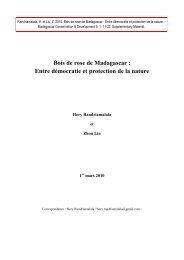Journal Madagascar Conservation - Madagascar Wildlife ...
Journal Madagascar Conservation - Madagascar Wildlife ...
Journal Madagascar Conservation - Madagascar Wildlife ...
You also want an ePaper? Increase the reach of your titles
YUMPU automatically turns print PDFs into web optimized ePapers that Google loves.
MADAGASCAR CONSERVATION & DEVELOPMENT VOLUME 3 | ISSUE 1 — DECEMBER 2008 PAGE 56<br />
FIGURE 1. Map of the Sainte Luce, Mandena and Petriky areas in southeast <strong>Madagascar</strong>, indicating the location of major littoral forest parcels (light green),<br />
including those that comprise the newly - established conservation zones at the three sites (dashed red and yellow lines).<br />
began collecting specimens as part of an effort to document<br />
the island’s woody plants in a new herbarium that had recently<br />
been established in Antananarivo by forest botanist René<br />
Capuron. Over the following three decades, approximately 500<br />
plant collections were made at Mandena, several of which<br />
represented species new to science, and Capuron himself<br />
visited the site on at least four occasions.<br />
Starting in 1986, QIT <strong>Madagascar</strong> Minerals (QMM) began an<br />
extensive exploration program along the eastern coast of<br />
<strong>Madagascar</strong> to locate deposits of heavy mineral sands containing<br />
titanium dioxide. Major mineral sediments were found<br />
at Mandena, Sainte Luce, and Petriky (for example Figure 1,<br />
2) underneath southeastern <strong>Madagascar</strong>’s largest remaining<br />
stands of littoral forest, a distinctive type of humid evergreen



